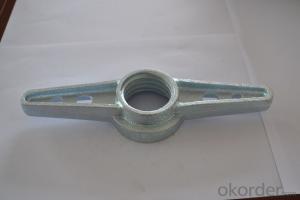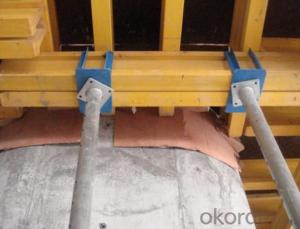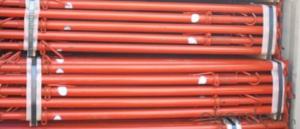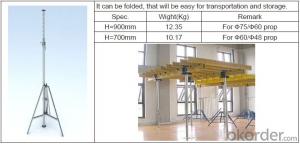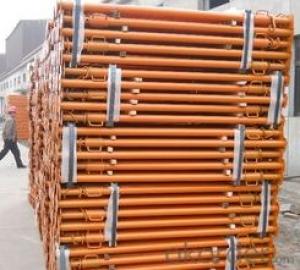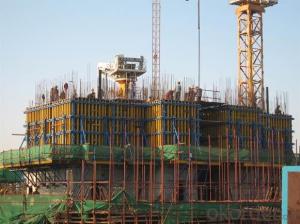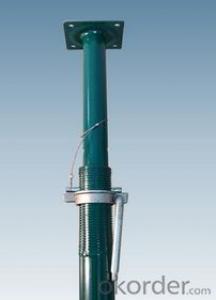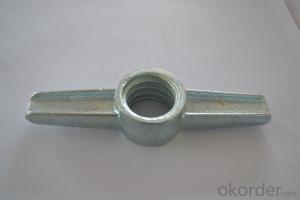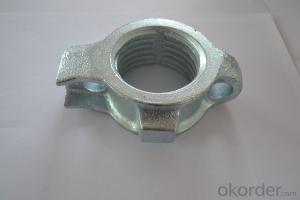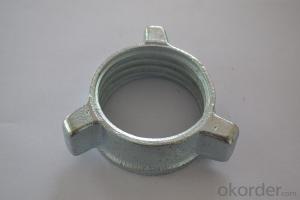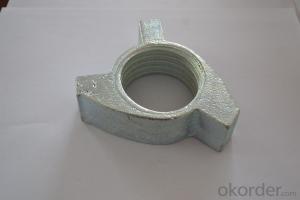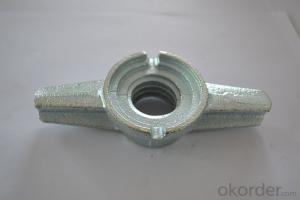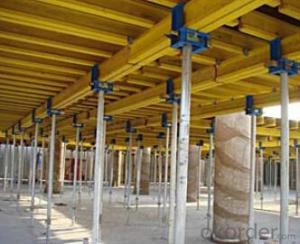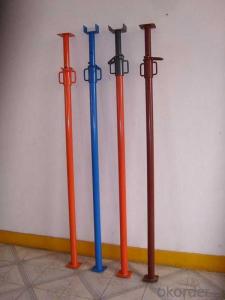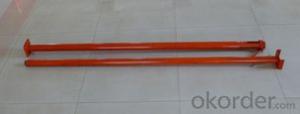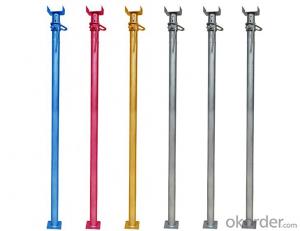OEM Two wing Butterfly Wing Nuts 13
- Loading Port:
- China Main Port
- Payment Terms:
- TT OR LC
- Min Order Qty:
- -
- Supply Capability:
- -
OKorder Service Pledge
OKorder Financial Service
You Might Also Like
Quick Details
| Model Number: | |||||
| Standard: | Type: | Certification: | |||
| Material: | Surface: |
Packaging & Delivery
| Packaging Detail: | Plastic bag, pallet packing, carton box, by customer's requirement |
| Delivery Detail: | within 30days after payment |
Specifications
Two wing Butterfly Wing Nuts
1>Excellent dimension accuracy
2>Finished: per your requirements
3>factory directly supply
Two wing Butterfly Wing Nuts
We supply kinds of metal parts totally according to clients' drawings and samples and special requirement.
1. Material: Ductile iron .
2. Sizes: Inner hole Dia 15/17mm.
We have different sizes ,types of wing nut to meet your needs, save your cost .
3. Weight: 0.35kg,thread pitch: 10.0mm.(or 6.35mm)
4. Surface: White Zinic , Yellow Zinic or painted, self color
5 Thread:casted or machine tap.
1. 12000M2 standard modern workshop guarantee production capability to satisfy the customers needs
2. Our Independent quality control department,Which make sure the quality of all products
3. Our efficient and experienced sales team ,provide friendly and thoughtful service for clients from all over the world
- Q: How do steel props contribute to the prevention of floor and wall deflection?
- Steel props contribute to the prevention of floor and wall deflection by providing temporary support and stability during construction or renovation projects. These props are adjustable and can be installed vertically to bear the weight of the floors and walls, ensuring they remain in their intended position. By providing additional support, steel props help distribute the load evenly, minimizing deflection or sagging that could occur due to excessive weight or movement.
- Q: Are steel props adjustable?
- Yes, steel props are adjustable. Steel props, also known as adjustable steel props or steel acrow props, are commonly used in construction and temporary support applications. They are designed to provide temporary support to beams, walls, or ceilings during construction or renovation projects. Steel props are usually made up of two main components: an outer tube and an inner tube. The outer tube is typically made of high-quality steel and has several holes along its length, while the inner tube can slide inside the outer tube and is used to adjust the height of the prop. To adjust the prop, you simply need to unlock the prop's collar and slide the inner tube up or down to the desired height. Once you've set the desired height, you lock the collar again to secure the prop in place. This adjustability feature allows steel props to be easily adjusted to different heights, making them versatile and flexible for various construction needs. Steel props are known for their strength, stability, and load-bearing capacity. They are commonly used in applications such as supporting formwork, scaffolding, or temporary structures. The adjustable nature of steel props allows for easy installation and removal, as well as the ability to adapt to different project requirements. Overall, steel props are a reliable and adjustable solution for temporary support needs in construction projects, providing stability and safety during the construction process.
- Q: Are steel props easy to transport and store?
- Yes, steel props are relatively easy to transport and store. They are lightweight and compact, making them convenient to carry and move around. Additionally, their adjustable design allows them to be collapsed to a smaller size for efficient storage.
- Q: How do you prevent theft or unauthorized use of steel props?
- To prevent theft or unauthorized use of steel props, several measures can be taken. First and foremost, implementing a robust security system, including surveillance cameras and alarms, can act as a deterrent. Additionally, securing the props in a locked storage area or using padlocks on individual props can enhance physical security. Maintaining an accurate inventory system with regular checks can help identify any missing or stolen props promptly. Lastly, educating employees about the importance of security measures and encouraging them to report any suspicious activity can further contribute to preventing theft or unauthorized use of steel props.
- Q: Can steel props be used in the construction of warehouses?
- Yes, steel props can be used in the construction of warehouses. Steel props are commonly used as temporary supports during the construction process. They are adjustable and can provide stability and support to the structure. Steel props can be used to support beams, columns, and other heavy loads in warehouses, ensuring the safety and stability of the building during construction. Once the construction is complete, the steel props can be removed or repositioned for use in other projects. Overall, steel props are a versatile and reliable solution that can be used effectively in the construction of warehouses.
- Q: How do steel props contribute to the overall stability of a building?
- Steel props contribute to the overall stability of a building by providing temporary support during construction or renovation works. These adjustable vertical supports are used to bear the load of the structure, ensuring that it remains stable and secure. The props transfer the weight of the building to the ground, preventing any potential collapse or movement. By distributing the load evenly, steel props help to maintain the structural integrity of the building, ensuring the safety of workers and the longevity of the structure.
- Q: What are the advantages of using steel props over other support systems?
- There are several advantages of using steel props over other support systems. Firstly, steel props are highly durable and have a high load-bearing capacity, making them suitable for supporting heavy loads. Secondly, steel props are adjustable, allowing for easy customization and flexibility in construction projects. Additionally, steel props are lightweight and easy to handle, making them convenient to transport and install. Lastly, steel props provide enhanced safety as they are designed to withstand various environmental conditions and are less prone to damage or collapse.
- Q: What are the maximum allowable deflections for steel props?
- The maximum allowable deflections for steel props depend on various factors such as the type of prop, its length, load capacity, and the specific application or industry standards being followed. In general, steel props are designed to provide temporary support or bracing in construction projects, and their deflection limitations are determined by structural engineering principles and safety considerations. For standard adjustable steel props commonly used in construction, the maximum allowable deflection is typically limited to a certain percentage of the prop's length. For example, it is common to restrict deflections to a maximum of 1/300th or 1/400th of the prop's length. So, for a prop with a length of 3 meters, the maximum allowable deflection might be around 7.5 mm to 10 mm. However, it is important to note that these values may vary depending on the specific regulations, building codes, or industry guidelines being followed in a particular region or country. Therefore, it is crucial to consult the relevant standards or seek guidance from a qualified structural engineer to determine the precise maximum allowable deflections for steel props in a given context.
- Q: Are steel props suitable for supporting temporary exhibition or display structures?
- Yes, steel props are suitable for supporting temporary exhibition or display structures. Steel props provide strong and stable support, making them ideal for holding up structures and ensuring their stability throughout the duration of the exhibition or display.
- Q: Are steel props suitable for supporting temporary ramps?
- Indeed, temporary ramps can be adequately supported by steel props. These props, which can also be referred to as adjustable steel props or shoring props, are commonly employed in the construction industry to offer temporary support to various structures, including ramps, floors, and beams. Their height can be easily adjusted to accommodate different ramp heights and slopes. Not only are steel props robust and long-lasting, capable of withstanding heavy loads, but they also provide stability to the structures they are supporting. Moreover, their installation and removal processes are straightforward, rendering them an ideal choice for temporary applications like ramps. In summary, steel props prove to be a dependable and fitting choice when it comes to supporting temporary ramps.
Send your message to us
OEM Two wing Butterfly Wing Nuts 13
- Loading Port:
- China Main Port
- Payment Terms:
- TT OR LC
- Min Order Qty:
- -
- Supply Capability:
- -
OKorder Service Pledge
OKorder Financial Service
Similar products
Hot products
Hot Searches
Related keywords
